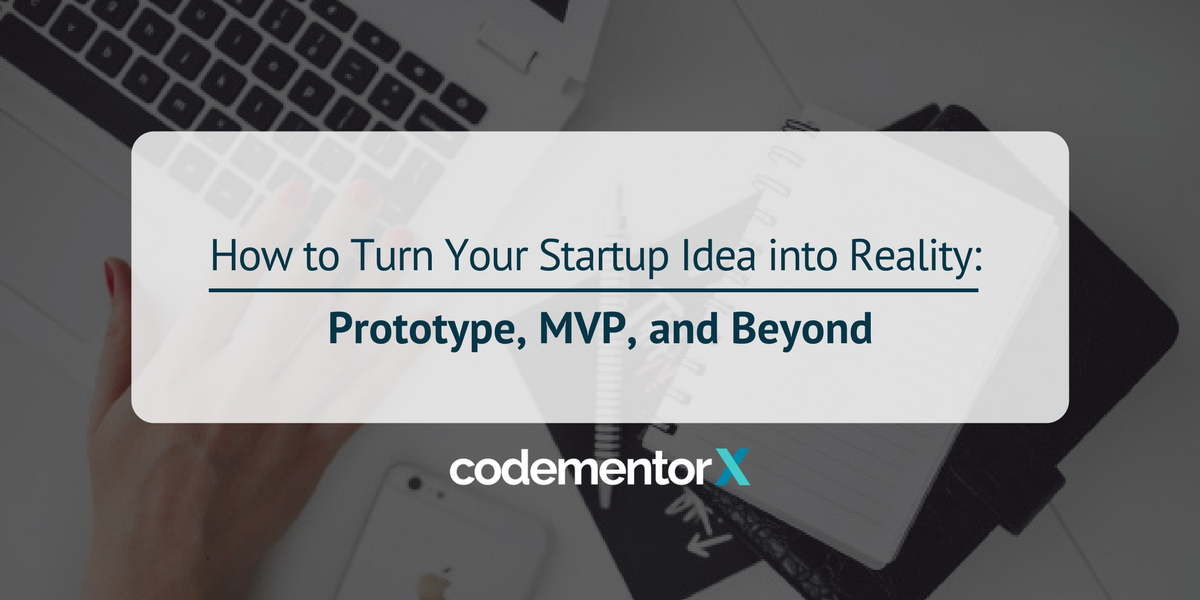When we think about the tech industry, the first thing that comes to mind is often “coding.” So is it possible for someone with no technical background and zero coding experience to build a successful tech startup? Believe it or not, the answer is yes! There are quite a few tech startups with non-technical founders which have reached an average valuation of USD $100M, including Pandora, Swig, WANELO, NerdWallet, Getaround, and Coffee Meets Bagel. Non-technical founders also started other renowned tech giants like Alibaba, Airbnb, and Amazon.
So how exactly did they succeed? If you are an entrepreneur with no tech background, what is the key to building a tech startup? Weiting Liu, the founder and CEO of Codementor, sat down with us in a recent Office Hours to discuss three key points to building tech startups as a non-tech founder:
- Building your prototype and MVP
- Building your technical team
- Contributing value as a non-technical founder
This blog post will briefly discuss each point with the aim of helping you be a successful non-technical founder!
Table of Contents
How to Build Your Prototype and MVP
Defining Your Prototype and MVP
The fundamental challenge every startup founder encounters is turning a great idea into a product. To validate your concept, the most common method is to build a prototype and an MVP. While these two product development approaches are both designed to prove product/market fit, prototypes will be developed before a minimum viable product (MVP). So what is the difference between a prototype and MVP?
Prototype: An early sample or model of a product built to demonstrate the feasibility of a concept. The aim of a prototype is to present your idea to your targeted audience. A prototype doesn’t necessarily need to be a working product. A simple landing page to introduce your concept can also work just as well. You can then decide on the viability of your concept based on the feedback you receive.
Based on the findings from your prototype and with much lower risk, you can move on to developing a MVP.
Minimum Viable Product (MVP): A first version of your software fit for your targeted customers with just enough features to test your concept’s workability and its continued development.
To dig deeper into the cost of building apps, check out this article explaining the cost of building the MVP of a top 10 iOS app.
How do I build my own prototype and MVP?
As a non-technical founder, how do you actually go about creating your prototype and MVP? In the Office Hours, Weiting shared four general approaches you can take:
- Build it yourself
- Work with freelancers
- Work with development agencies
- Work with a partner or technical co-founder
Let’s dive into what each method entails and some of their pros and cons.
Build it Yourself
The first way to approach building your prototype and MVP is to create it yourself. We'll talk about prototypes and MVPs separately, since in most cases, they require vastly different technical skills.
Prototype
With access to various useful online tools, you can build a prototype alone even as a non-technical founder. Tools such as Wordpress, Typeform, and other drag-and-drop sites like Squarespace and Weebly provide ready-made templates that are fast and easy. In addition, other tools such as Marvel, Mockplus, Adobe XD, and Invision allow you to mimic user experience and improving your design workflow. With easy access to various online tools, you can make the most efficient and user-friendly products even by yourself.
Though ready-made templates are easy to work on and economical in building your prototypes, there are also disadvantages that you might want to consider. These include the time you’ll spend on finding tools you’re comfortable working with and the fact that ready-made templates limit your creativity in designing your site.
Pros:
- Modern tools are convenient and easy to work with
- A very inexpensive option
Cons:
- Exploration process and time to find the right tool
- Design and layout aren’t as flexible
Minimum Viable Product (MVP)
If you’re ready to move on to creating an MVP and like taking on challenges, you can choose to build your own MVP by coding! There are many online step-by-step guidelines to teach how to design and code simple, easy websites. By coding the MVP yourself, you have total control over your site’s designs and layout, not to mention you get to learn how to code! You’ll also gain a deeper understanding of your product and be able to communicate more effectively with future engineers. The downside would be that it takes time, so this may not be the best solution if you’re on a tight schedule. You should also keep in mind that your code base will most likely not be reusable, and your future engineers may have to rewrite.
Pros:
- Total control of design and layout
- Hands-on coding experience
- Will be cheaper than hiring outside developers
Cons:
- Will cost you time to learn how to code
- Code base most likely will not be reusable, and your future engineers may have to rewrite everything
Codementor’s MVP
An example of a self-built MVP is Codementor. Codementor’s MVP was built by Weiting, our founder, using Ruby on Rails, because it offers a huge vibrant community he could easily turn to for help. After the MVP was built in 2013, Weiting shared Codementor’s landing page on Hacker News, and we made it to the front page. As a result, we received a ton of feedback from developers, providing us an opportunity to build up our initial user base and find future potential partners and users. This is a great way to introduce your product to an already existing online community
Work with Freelancers
The second way non-technical founders can build an MVP is by working with freelancers. Freelancers are self-employed and usually not committed to a particular employer for the long-term. You can find freelancers either locally or through online platforms.
Working with freelancers is an efficient way to create your MVP if you’re running on a tight deadline and budget. However, the quality of freelancers on many freelancing platforms cannot be guaranteed, thus many projects run the risk of failure. Regardless of where you find a freelancer, the key to a successful relationship is constant communication. When getting a quote for a task or project, be sure to provide the freelancer with a list of your specifications and a copy of your wireframes to avoid overestimation of the cost or time needed.
Pros:
- Will take less time than coding yourself and allows you to focus on other matters
- Less expensive compared to working with development agencies
Cons:
- Inconsistent quality
- May be difficult to communicate effectively with freelancers
Due to the uncertainty of freelancer quality, the failure rate is often high. Nevertheless, there have been a few startups which succeeded in using freelancers. WANELO, an online community for stores and products, is famously built by freelancers. As a designer, WANELO’s founder, Deena Varshavskaya, had prior experience working with freelancers and developers. She also had experience building mobile products. These experiences enabled her to act as the product manager during WANELO’s MVP stage. Ultimately, this was what led to a successful MVP built by freelancers.
In general, using freelancers to build an MVP is only recommended when the founder has prior product/project management experience or experience working with freelancers.
Work with Development Agencies
Another popular and efficient way to build an MVP is to work with development agencies. Development agencies offer extensive services that can transform your ideas into the best MVP it can be. With the quality guaranteed, it is often reflected on the cost which is prohibitively high for early stage entrepreneurs. What’s more, working with development agencies usually require rigid contracts that lack flexibility. Therefore, when you encounter unexpected changes, you can’t simply alter your project plan easily.
Pros:
- Quick turnaround in finding suitable developers
- More consistent quality and quality assurance
Cons:
- Higher cost
- Less flexible contract
There are many agencies with a proven track record on building great MVPs. If you’re not sure which agency to go with, we would recommend taking a look at online review sites such as Clutch.io, which offer honest third party reviews. Another hybrid solution is to work with a second generation pre-vetted developer platforms like CodementorX. These platforms offer a network of experienced freelancers and free trial periods, so you can feel absolutely comfortable with your chosen freelancer before hiring him or her for your MVP.
Work with a Partner or Technical Co-founder
Working with a technical co-founder is the most ideal way of building your MVP. However, it is also often most difficult approach because you’ll have to convince someone of the validity of your concept, so that they’ll join you on a journey full of uncertainties and oftentimes very little pay. If you decide to look for a technical co-founder, we recommend looking within your own network first. The ideal partner would be someone you have worked with before, so there is mutual trust already established.
Pros:
- Someone to challenge your personal assumptions and drive better product development
- Someone to build your site the way you want
Cons:
- May be difficult turning a friendship into a working relationship
- Your co-founder or CTO may only bring technical skills to the table
If you are sure that your business is scaling or will scale soon, finding a technical co-founder or CTO may be the best approach. Someone who understands the tech world and can iterate your product quickly enough to catch up with your startup’s growth can help grow your startup quickly. You’ll be facing a mountain of risks and challenges along the way and having a co-founder also just makes this journey less lonely and daunting.
For founders who choose not to find a technical co-founder at this stage, how should you go about hiring your first engineer?
How to Build Your Technical Team
The next key point of success for non-technical founders is building a technical team. Whether your first engineer is an early engineer hire or the CTO, one thing is certain — you need to start building your tech team as soon as possible.
Build up Your Engineering Team as Early as Possible
Since your product is still in early stages, often times, the product itself is the company. In other words, you still have the capability of coping with user feedback, making UX decisions, and iterating your product. This means that it may not be necessary to find a technical co-founder at this stage. Truth be told, it is also quite difficult to find an experienced developer who is willing to leave behind his or her job to join you on the startup adventure as the CTO.
In this case, we recommended building up your technical team by hiring your first developer(s). Startup founders often find the the process of searching for the right engineering hire very lengthy and difficult, so you can also consider hiring a long-term freelancer. We would caution, however, that the failure rate for this approach is fairly high. Your product iteration cycle will most likely be too long to make the progress your users want to see.
Hire a CTO or Engineering Lead at the Right Time
If you’ve been taking on the product manager role and have hired a few engineers to your tech team, when would be the right time to find a CTO?
In the early stages of your startup, it’s best to iterate your product quickly, usually on a weekly basis. If you notice that your team is starting to run behind schedule or you’re not able to fully concentrate on your product, it’s a sign that you need to find a technical co-founder or CTO to lead them. Finding a technical partner will save you time and allow you to focus on other things that are equally essential to the growth of your startup.
Hire Through Your Personal Network
As non-technical founders, it’s probably quite stressful to solve technical issues, therefore hiring developers would be great to distribute your stress. It’s not hard to find a developer, but how can you guarantee quality? Where should you scout for suitable candidates?
The first recommended approach is to search through your personal network and see if there are potential candidates that you’ve worked with before. Attending local entrepreneurship meetups is also a great way expand your network and potentially find someone you want to work with. To make a lasting impression, use tools like The QR Code Generator to create QR codes that quickly share your brand or idea.
Pro tip: When vetting developer candidates, hire them as short-term contractors first to try things out.
How did Codementor build its dev team?
Weiting hired his first developer as a contractor for a few months and decided to start hiring full-time engineers, which he found through his personal network and had prior experience with. After his first batch, the following engineers mostly came from the engineer’s personal connections.
How to Continue Contributing Value
After building your MVP and your tech team, you’ll need to focus on the last key issue for a non-technical founder — continue contributing value to your team. Unlike building MVPs and recruiting your tech team, this is a long-term goal you’ll need to focus on and continue adapting at every stage of your startup.
As a non-technical founder, it is essential to know your role. During the first phase for your startup, it’s all about achieving product/market fit. Without many resources and funds, the founder usually has to work on product management, business development/sales, marketing, fundraising, etc. As a non-technical founder, you’ll need to be a jack of all trades. As your startup continues to grow and scale, you should consider how you can continue contributing value. It is not uncommon to see non-technical founders stepping down from their companies after a few rounds of funding.
Be an Industry Expert
Non-technical founders often build startups in their own domain of experience. A famous example would be Flexport, a freight forwarding company. The founders of Flexport came from the global trade freight forwarding businesses themselves, meaning they had in-depth knowledge about the industry. They understood what the pain point in industry was and came up with a solution that disrupted the “file cabinet industries.” For founders who aren’t experienced domain experts in their industry, we recommend doing the work to become an industry expert.
Be a Charismatic Leader
Going into the growth stage, your startup will continue maturing and scaling. This means your team will expand. As you dealing with more employees, you need to become a charismatic leader. A great example of this is Jack Ma from Alibaba. With no background in technology, he stands out as a non-technical founder for an extremely successful tech company. As Alibaba left the startup stage, Jack Ma continued to contribute his value as an educator and efficient communicator. It’s important to identify your skills and learn to use them in your role as a founder, including potentially acquiring recruiter certifications to enhance your leadership abilities.
Final Thoughts & Office Hours Video
With many successful examples of non-technical founders running great tech startups, don’t underestimate your capability.
Regardless of how you build your prototype and MVP, always remember to evaluate your product at its current state and choose the most suitable approach. Once you’re past the MVP stage, you will need to attract users and gather feedback to iterate your product. To sustain your growth, you’ll need to next focus on building your tech team. This doesn’t necessarily mean you have to search for a tech co-founder immediately, but you should find and hire the engineers you need. Finally, as a non-technical founder, you need to constantly contributing value. In early stages, be the jack of all trades, and as your company scales, become an industry expert or a charismatic leader.
For even more tips on how to build a successful startup as a non-technical founder, watch Weiting’s Office Hours below.
Good luck with your startup, and feel free to let us know your thoughts in the comments section below!
This post was based on an Office Hours with Weiting Liu, CEO and founder of Codementor.



